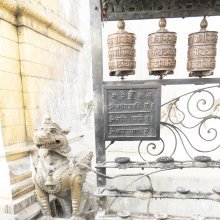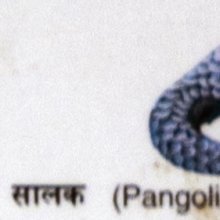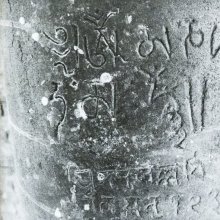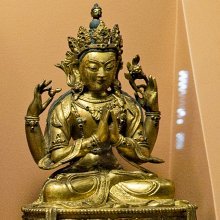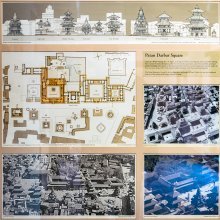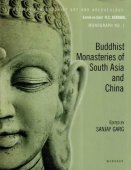Mani, Maṇī, Mānī, Maṇi, Māṉi: 42 definitions
Introduction:
Mani means something in Buddhism, Pali, Hinduism, Sanskrit, Jainism, Prakrit, the history of ancient India, Marathi, Hindi, biology, Tamil. If you want to know the exact meaning, history, etymology or English translation of this term then check out the descriptions on this page. Add your comment or reference to a book if you want to contribute to this summary article.
Images (photo gallery)
In Hinduism
Shaivism (Shaiva philosophy)
Source: Wisdom Library: Kubjikāmata-tantraMaṇi (मणि):—Name of one of the six deities which together form the third of the six groups of the aṣṭāviṃśatikrama (one of the main components in the worship of Kubjikā). This group of six deities is also referred to as ‘the auspicious six’ (anugraha-ṣaṭka) and is located in the Ghaṭasthāna. Their names are referred to in the kubjikāmata-tantra but actually described in the Ṣaṭsāhasra-saṃhitā.

Shaiva (शैव, śaiva) or Shaivism (śaivism) represents a tradition of Hinduism worshiping Shiva as the supreme being. Closely related to Shaktism, Shaiva literature includes a range of scriptures, including Tantras, while the root of this tradition may be traced back to the ancient Vedas.
Purana and Itihasa (epic history)
Source: archive.org: Puranic Encyclopedia1) Maṇi (मणि).—A serpent born of the family of Dhṛtarāṣṭra. This serpent was burnt to death in the Sarpasatra of Janamejaya. (Śloka 19, Chapter 57, Ādi Parva).
2) Maṇi (मणि).—A sage. This sage was a member of the Brahmasabhā. (Śloka 24, Chapter 11, Sabhā Parva).
3) Maṇi (मणि).—One of the two Pārṣadas given to Subrahmaṇya by Candra. The other one was named Sumaṇi. (Śloka 32, Chapter 45, Śalya Parva).
4) Maṇi (मणि).—A son born to Kaśyapaprajāpati of his wife Kadrū. Maṇi lived near the city of Girivraja. This serpent did penance to please Śiva and obtained a boon that Garuḍa should give refuge to him. (31: 6, Ādi Parva and Brahmāṇḍa Purāṇa).
Source: Cologne Digital Sanskrit Dictionaries: The Purana Index1a) Maṇi (मणि).—A jewel of the king.*
- * Brahmāṇḍa-purāṇa II. 29. 75; IV. 21. 12; Vāyu-purāṇa 57. 68; 78. 53.
1b) A Kādraveya Nāga.*
- * Brahmāṇḍa-purāṇa III. 7. 37; Vāyu-purāṇa 69. 74.
1c) Gems as ornaments of Nāgas.*
- * Viṣṇu-purāṇa II. 5. 6.
Maṇi (मणि) is a name mentioned in the Mahābhārata (cf. V.101.10/V.103, IX.44.29) and represents one of the many proper names used for people and places. Note: The Mahābhārata (mentioning Maṇi) is a Sanskrit epic poem consisting of 100,000 ślokas (metrical verses) and is over 2000 years old.

The Purana (पुराण, purāṇas) refers to Sanskrit literature preserving ancient India’s vast cultural history, including historical legends, religious ceremonies, various arts and sciences. The eighteen mahapuranas total over 400,000 shlokas (metrical couplets) and date to at least several centuries BCE.
Shilpashastra (iconography)
Source: Shodhganga: The significance of the mūla-beras (śilpa)Maṇi (“bell”) refers to one of the several “attributes” (āyudha) or “accessories” of a detiy commonly seen depicted in Hindu iconography, defined according to texts dealing with śilpa (arts and crafs), known as śilpaśāstras.—The śilpa texts have classified the various accessories under the broad heading of āyudha or karuvi (implement), including even flowers, animals, and musical instruments. The other miscellaneous articles found as attributes in the hands of the deities are, for example, Maṇi.
Maṇi also represents “tangible form of sound”, referring to one of the attributes of Lord Śiva.

Shilpashastra (शिल्पशास्त्र, śilpaśāstra) represents the ancient Indian science (shastra) of creative arts (shilpa) such as sculpture, iconography and painting. Closely related to Vastushastra (architecture), they often share the same literature.
Vaishnavism (Vaishava dharma)
Source: Pure Bhakti: Brhad BhagavatamrtamMaṇi (मणि) refers to:—A jewel. (cf. Glossary page from Śrī Bṛhad-bhāgavatāmṛta).

Vaishnava (वैष्णव, vaiṣṇava) or vaishnavism (vaiṣṇavism) represents a tradition of Hinduism worshipping Vishnu as the supreme Lord. Similar to the Shaktism and Shaivism traditions, Vaishnavism also developed as an individual movement, famous for its exposition of the dashavatara (‘ten avatars of Vishnu’).
Shaktism (Shakta philosophy)
Source: Google Books: ManthanabhairavatantramMaṇi (मणि) refers to “gems”, according to the Kaulajñānanirṇaya.—Accordingly, “The Nameless (energy) [i.e., anāmā] is fixed in the Heart [i.e., hṛdaya]. This is the Gesture (mudrā) that bestows the goddess. If one sees her in the End of the Twelve, she shines (like) a necklace of gems [i.e., maṇi-mālikā]. This is the Gesture (mudrā) called Anāmā; once (it is) known (one attains) the (liberated) sky-faring state. O beloved, one must break though the door which, endowed with consciousness, is sealed with the Five Seals (of the lower Wheels) and is well obstructed by the chain (of the door). [...]”.
Source: Brill: Śaivism and the Tantric Traditions (shaktism)Maṇi (मणि) refers to “(decorative) jewels”, according to the King Vatsarāja’s Pūjāstuti called the Kāmasiddhistuti (also Vāmakeśvarīstuti), guiding one through the worship of the Goddess Nityā.—Accordingly, “[...] She has braided hair. Her limbs are adorned with bracelets, earrings, necklaces, twining laces, girdles, jewels (maṇi), and anklets. Her clothes resemble Bandhūka flowers. She is full of affection, and the hue of her body is brightened up with saffron and sandal paste.. [...]”.

Shakta (शाक्त, śākta) or Shaktism (śāktism) represents a tradition of Hinduism where the Goddess (Devi) is revered and worshipped. Shakta literature includes a range of scriptures, including various Agamas and Tantras, although its roots may be traced back to the Vedas.
Jyotisha (astronomy and astrology)
Source: Wisdom Library: Brihat Samhita by Varahamihira1) Maṇi (मणि) refers to a “gem”, according the Bṛhatsaṃhitā (chapter 7), an encyclopedic Sanskrit work written by Varāhamihira mainly focusing on the science of ancient Indian astronomy astronomy (Jyotiṣa).—Accordingly, “When Mercury should disappear, the chief towns in the land will be besieged by enemies, but when he reappears the siege will be raised. According to some writers, the latter occurs only when Mercury reappears as an evening star; and learned writers also say that the chief rulers will also get an accession of territories. If Mercury should be of the colour of gold or of a parrot or if he should resemble the hue of the Sasyaka gem [i.e., maṇi], or if his disc should appear glossy or big in size, mankind will be happy; but if otherwise, they will be afflicted with miseries”.
2) Maṇi (मणि) or Maṇiketu refers to a particular type of Ketus (i.e., luminous bodies such as comets and meteors), according to the Bṛhatsaṃhitā (chapter 11).— Accordingly, “Kumuda Ketu is a comet of the colour of the white water lily. It appears in the west with its tail pointing to the east and is visible only for a night. When it appears there will be unprecedented happiness in the land for a period of ten years. Maṇi Ketu is a comet which appears for only 3 hours occasionally; it possesses an invisible disc and appears in the west; its tail is straight and white and it resembles a line of milk drawn from a human breast. There will be happiness in the land from the very time of its appearance for four and a half months; reptiles and venomous creatures will come into existence”.

Jyotisha (ज्योतिष, jyotiṣa or jyotish) refers to ‘astronomy’ or “Vedic astrology” and represents the fifth of the six Vedangas (additional sciences to be studied along with the Vedas). Jyotisha concerns itself with the study and prediction of the movements of celestial bodies, in order to calculate the auspicious time for rituals and ceremonies.
Kavya (poetry)
Source: Brill: Śaivism and the Tantric Traditions (kavya)Maṇi (मणि) refers to a “precious stone”, according to Kālidāsa’s Raghuvaṃśa verse 3.18.—Accordingly: “When the complete birth ritual was done by the ascetic chaplain who had come from the grove of ascetics, Dilīpa’s son shone yet more, like a precious stone (maṇi) taken from a mine and then polished”.

Kavya (काव्य, kavya) refers to Sanskrit poetry, a popular ancient Indian tradition of literature. There have been many Sanskrit poets over the ages, hailing from ancient India and beyond. This topic includes mahakavya, or ‘epic poetry’ and natya, or ‘dramatic poetry’.
Pancaratra (worship of Nārāyaṇa)
Source: University of Vienna: Sudarśana's Worship at the Royal Court According to the AhirbudhnyasaṃhitāMaṇi (मणि) refers to “(decorations of) gems”, according to the Ahirbudhnyasaṃhitā, belonging to the Pāñcarātra tradition which deals with theology, rituals, iconography, narrative mythology and others.—Accordingly, “He should have the supreme Yantra constructed out of refined gold, with decorations of gems (maṇi) and coral and with all [the necessary] adornments. Just by making this, he shall obtain territory free of disorders. Having [properly] installed it, he should respectfully worship this [Yantra] which bestows all accomplishments. [...]”.

Pancaratra (पाञ्चरात्र, pāñcarātra) represents a tradition of Hinduism where Narayana is revered and worshipped. Closeley related to Vaishnavism, the Pancaratra literature includes various Agamas and tantras incorporating many Vaishnava philosophies.
Kama-shastra (the science of Love-making)
Source: Shodhganga: Elements of Art and Architecture in the Trtiyakhanda of the Visnudharmottarapurana (kama)Maṇi (मणि) refers to “jewels”.—Cf. Maṇirāgākarajñāna which refers to “knowledge of jewel, colours and mines”, representing one of the “sixty four kinds of Art”, according to the Kāmasūtra of Vātsyāyaṇa.—Indian tradition, basically includes sixty four Art forms are acknowledged. The references of sixty four kinds of kalā are found in the Bhāgavatapurāṇa, Śaiva-Tantras, Kāmasūtra of Vātsyāyaṇa etc.
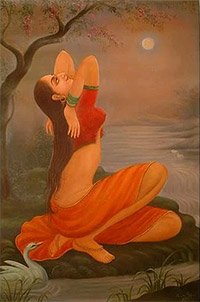
Kamashastra (कामशास्त्र, kāmaśāstra) deals with ancient Indian science of love-making, passion, emotions and other related topics dealing with the pleasures of the senses.
Ayurveda (science of life)
Source: Chulalongkorn University: Department of Eastern Languages (Pali-Sanskrit Section) (ay)Maṇi (मणि) (in the Atharva-veda) is a small round object. They are made from natural plant parts or from the solid coverings of animal bodies. It has the properties of being an amulet for protection and warding off evil spirits. or as an herb for treating illnesses Some types of maṇi can be drilled with holes, threaded with strings, and worn as jewelry. The Atharva-veda also states that Wearing jewelry made from Mani like this is believed to give one a long life.
Sudev Krishna Sharman G. listed 9 types of Maṇi according to the Atharvaveda. Including specifying assumptions about the meaning as follows.
- jaṅgiḍa-maṇi—means calamus (Acorus calamus, Terminalia arjuneya)
- pratisarā-maṇi—means sesame (Seasamum).
- varaṇa-maṇi—means water kum tree (Crateva roxburghii).
- astṛta-maṇi—refers to herbs made from milk, honey and ghee.
- darbha-maṇi—means Kusa grass or sacred grass used in rituals. Religious (Desmostachya bipinnata)
- auḍumbara-maṇi—means fig fruit (Ficus glomerata).
- śaṅkha-maṇi [sangkhamani]—means pearl from the conch shell (Strombus gigas or Conch Pearl).
- śatavāra-maṇi—means elephant coriander (Asparagus racemosus).
- phāla-maṇi—means Acacia catechu.

Āyurveda (आयुर्वेद, ayurveda) is a branch of Indian science dealing with medicine, herbalism, taxology, anatomy, surgery, alchemy and related topics. Traditional practice of Āyurveda in ancient India dates back to at least the first millenium BC. Literature is commonly written in Sanskrit using various poetic metres.
Sports, Arts and Entertainment (wordly enjoyments)
Source: archive.org: Syainika Sastra of Rudradeva with English Translation (art)Maṇi (मणि) refers to “precious stones” (which were commonly collected by hunters), according to the Śyainika-śāstra: a Sanskrit treatise dealing with the divisions and benefits of Hunting and Hawking, written by Rājā Rudradeva (or Candradeva) in possibly the 13th century.—Accordingly, “Hunting on horseback (āśvina) represents one of the eight subdivisions of Hunting (mṛgayā). [...] It leads to the acquisition of wealth by the capture of wild elephants and rhinoceros, by collecting horns and hides, musk and precious stones (maṇi), feathers and such like things. [...]”.

This section covers the skills and profiencies of the Kalas (“performing arts”) and Shastras (“sciences”) involving ancient Indian traditions of sports, games, arts, entertainment, love-making and other means of wordly enjoyments. Traditionally these topics were dealt with in Sanskrit treatises explaing the philosophy and the justification of enjoying the pleasures of the senses.
In Buddhism
Theravada (major branch of Buddhism)
Source: Pali Kanon: Pali Proper NamesA yakkha chief, to be invoked by Buddhists in time of need. D.iii.205.
Theravāda is a major branch of Buddhism having the the Pali canon (tipitaka) as their canonical literature, which includes the vinaya-pitaka (monastic rules), the sutta-pitaka (Buddhist sermons) and the abhidhamma-pitaka (philosophy and psychology).
Tibetan Buddhism (Vajrayana or tantric Buddhism)
Source: academia.edu: The Structure and Meanings of the Heruka MaṇḍalaMaṇī (मणी) is the name of a Ḍākinī who, together with the Vīra (hero) named Maṇi forms one of the 36 pairs situated in the Jalacakra, according to the 10th century Ḍākārṇava chapter 15. Accordingly, the jalacakra refers to one of the three divisions of the saṃbhoga-puṭa (‘enjoyment layer’), situated in the Herukamaṇḍala. The 36 pairs of Ḍākinīs [viz., Maṇī] and Vīras are white in color; the shapes of their faces are in accordance with their names; they have four arms; they hold a skull bowl, a skull staff, a small drum, and a knife..
Source: ORA: Amanaska (king of all yogas): (Tibetan Buddhism)Maṇi (मणि) refers to a “(pure) gem”, according to the thirty-third chapter of the Saṃvarodayatantra: a Buddhist explanatory Tantra of the Cakrasaṃvara cycle.—Accordingly, while describing the no-mind meditation: “[...] Free from meditation and concentration and beyond [both] Yoga and reasoning, he leads people to absorption in ‘suchness’, when the mind becomes steady in awareness. Its form is like the sky, the dwelling place of the ether and like a pure crystal and gem (maṇi), [it is] without beginning or end, unelaborated, beyond the senses, unchanging, without appearance, completely void, free of ills, the light of the world, the destruction of the bonds of existence, inexpressible by words and even beyond the sphere of the mind”.

Tibetan Buddhism includes schools such as Nyingma, Kadampa, Kagyu and Gelug. Their primary canon of literature is divided in two broad categories: The Kangyur, which consists of Buddha’s words, and the Tengyur, which includes commentaries from various sources. Esotericism and tantra techniques (vajrayāna) are collected indepently.
Mahayana (major branch of Buddhism)
Source: Wisdom Library: Maha Prajnaparamita SastraKuṇapa (कुणप) refers to a “pearl”, according to Mahāprajñāpāramitāśāstra (chapter 21).—Accordingly, “The immoral person is not respected (satkṛta) by people; his house is like a cemetery into which people do not go; he loses all his virtues like a rotten tree that people despise; [...] Even though he has the external appearance of a Bhikṣu, one would say he is a corpse in the midst of sleepers. He is like a false pearl (maṇi) among real pearls, like a castor-bean tree in a sandalwood forest. Even though outwardly he looks like an honest man, inwardly he is without good qualities. Even though he is called Bhikṣu because he has a shaved head, the yellow robe and presents his ‘ticket’ in the proper order, in reality he is not a Bhikṣu”.

Mahayana (महायान, mahāyāna) is a major branch of Buddhism focusing on the path of a Bodhisattva (spiritual aspirants/ enlightened beings). Extant literature is vast and primarely composed in the Sanskrit language. There are many sūtras of which some of the earliest are the various Prajñāpāramitā sūtras.
General definition (in Buddhism)
Source: Wisdom Library: Dharma-samgrahaMaṇi (मणि, “gem”) or Maṇiratna refers to the “gem jewel” and represents the fourth of the “seven jewels of universal monarchs” (saptaratna) as defined in the Dharma-saṃgraha (section 85). The Dharma-samgraha (Dharmasangraha) is an extensive glossary of Buddhist technical terms in Sanskrit (e.g., maṇi). The work is attributed to Nagarjuna who lived around the 2nd century A.D.
In Jainism
General definition (in Jainism)
Source: Google Books: Jainism: An Indian Religion of SalvationMaṇi (मणि, “gem”).—One of the fourteen gems (ratna) serving the Cakravartin;—The maṇi is a gem of uncomparable dazzle belonging to a particular type of cat-yes (vaiḍūrya). IT lends victory, cures wounds and illuminates darkness as bright as the sun.

Jainism is an Indian religion of Dharma whose doctrine revolves around harmlessness (ahimsa) towards every living being. The two major branches (Digambara and Svetambara) of Jainism stimulate self-control (or, shramana, ‘self-reliance’) and spiritual development through a path of peace for the soul to progess to the ultimate goal.
India history and geography
Source: Cologne Digital Sanskrit Dictionaries: Indian Epigraphical GlossaryMaṇi.—(IA 20), a burning glass. Note: maṇi is defined in the “Indian epigraphical glossary” as it can be found on ancient inscriptions commonly written in Sanskrit, Prakrit or Dravidian languages.
--- OR ---
Māni.—(LP), a measure of capacity equal to about 6 maunds. (SII 11-1), Kannaḍa; also spelt Māṇi; a bachelor; Brahmacārin. Note: māni is defined in the “Indian epigraphical glossary” as it can be found on ancient inscriptions commonly written in Sanskrit, Prakrit or Dravidian languages.
--- OR ---
Māṇi.—(EI 14; Chamba), name of a measure. Note: māṇi is defined in the “Indian epigraphical glossary” as it can be found on ancient inscriptions commonly written in Sanskrit, Prakrit or Dravidian languages.

The history of India traces the identification of countries, villages, towns and other regions of India, as well as mythology, zoology, royal dynasties, rulers, tribes, local festivities and traditions and regional languages. Ancient India enjoyed religious freedom and encourages the path of Dharma, a concept common to Buddhism, Hinduism, and Jainism.
Biology (plants and animals)
Source: Google Books: CRC World Dictionary (Regional names)1) Mani in English is the name of a plant defined with Arachis hypogaea in various botanical sources. This page contains potential references in Ayurveda, modern medicine, and other folk traditions or local practices It has the synonym Arachis hypogaea fo. nambyquarae (Hoehne) F.J. Herm. (among others).
2) Mani in India is also identified with Daemia extensa It has the synonym Daemia extensa (Jacq.) R. Br. ex Schult. (etc.).
3) Mani is also identified with Hyoscyamus niger It has the synonym Hyoscyamus agrestis Kitaibel ex Schultes (etc.).
4) Mani is also identified with Pergularia daemia It has the synonym Asclepias scandens P. Beauv. (etc.).
Example references for further research on medicinal uses or toxicity (see latin names for full list):
· Miscellanea Austriaca ad Botanicam, Chemiam, et Historiam Naturalem Spectantia (1781)
· Ciencia e Cultura (1976)
· Flora AegyptiacoArabica (1775)
· Genome (1987)
· Systema Vegetabilium (1820)
· Bocconea, Monographiae Herbarii Mediterranei Panormitani (1991)
If you are looking for specific details regarding Mani, for example diet and recipes, side effects, chemical composition, pregnancy safety, extract dosage, health benefits, have a look at these references.

This sections includes definitions from the five kingdoms of living things: Animals, Plants, Fungi, Protists and Monera. It will include both the official binomial nomenclature (scientific names usually in Latin) as well as regional spellings and variants.
Languages of India and abroad
Pali-English dictionary
Source: BuddhaSasana: Concise Pali-English Dictionary1) maṇi : (m.) a gem; jewel.
2) mānī : (m.) one who is proud.
Source: Sutta: The Pali Text Society's Pali-English DictionaryMaṇi, (cp. Vedic maṇi. The connection with Lat. monile (pendant), proposed by Fick & Grassmann, is doubted by Walde, Lat. Wtb. s. v. monile, where see other suggestions. For further characterisation of maṇi cp. Zimmer, Altindisches Leben pp. 53, 263) 1. a gem, jewel. At several places one may interpret as “crystal. ” ‹-› D. I, 7 (as ornament); Dh. 161; J. VI, 265 (agghiya, precious). In simile at D. I, 76 (maṇi veḷuriyo). On maṇi in similes see J. P. T. S. 1907, 121.—udaka-pasādaka maṇi a precious stone (crystal?) having the property of making water clear Miln. 35 (cp. below Vism. 366 passage); cintā° a “thought-jewel, ” magic stone (crystal?) J. III, 504; VvA. 32; cūḷā° a jewelled crest or diadem, the crown-jewel J. V, 441 sq.; jāti° a genuine precious stone J. II, 417; Vism. 216 (in comparison); tārā° (-vitāna) (canopy) of jewelled stars Vism. 76; nīla° a dark blue jewel J. II, 112; IV, 140; DhA. III, 254. The passage “amaṇiṃ udakaṃ maṇiṃ katvā” at Vism. 366 (+asuvaṇṇaṃ leḍḍuṃ suvaṇṇaṃ katvā) refers clearly to meaning “jewel” (that the water is without a jewel or crystal, but is made as clear as crystal; a conjuror’s trick, cp. Miln. 35). Whether meaning “waterpot” (as given at Abhp 1113 & found in der. maṇika) is referred to here, is not to be decided.—2. a crystal used as burning-glass Miln. 54.

Pali is the language of the Tipiṭaka, which is the sacred canon of Theravāda Buddhism and contains much of the Buddha’s speech. Closeley related to Sanskrit, both languages are used interchangeably between religions.
Marathi-English dictionary
Source: DDSA: The Molesworth Marathi and English Dictionary1) Maṇi (मणि).—m (S) A gem, bead &c. See maṇī.
2) maṇī (मणी).—m (S) A gem, jewel, bead, or precious stone. Pr. sutāsāṭhīṃ maṇī phōḍaṇēṃ. 2 Glans penis. 3 Clitoris. 4 Applied, figuratively, to a person eminent in any way. 5 A knob of wood; a pulleyblock; a wooden loop &c. through which a rope is reeved. 6 The scanty and light grains of corn which fall during the winnowing of nikaṇa which see and also madana. 7 Semen virile.
3) manī (मनी).—f A fondling name for a cat, answering to pussy, puss.
4) māṇī (माणी).—f (Commonly māyaṇī or nī) A ferrule; an annular lining &c.
5) mānī (मानी).—a (māna) Proud, haughty, lofty. 2 (With implication of praise.) Spirited, noble, highminded.
mānī (मानी).—f C (māna The neck.) The annular lining of the mouth-piece of a handmill. 2 C The groove of the upper leaf of a handmill, for the reception of the pāṭī or slip of iron which is to sustain the revolutions of the pin.
Source: DDSA: The Aryabhusan school dictionary, Marathi-English1) Maṇi (मणि) [-ṇī, -णी].—m A gem, bead.
2) manī (मनी).—f A fondling name for a cat, answering to a Pussy, a puss.
3) mānī (मानी).—a Proud. Spirited.
Marathi is an Indo-European language having over 70 million native speakers people in (predominantly) Maharashtra India. Marathi, like many other Indo-Aryan languages, evolved from early forms of Prakrit, which itself is a subset of Sanskrit, one of the most ancient languages of the world.
Sanskrit dictionary
Source: DDSA: The practical Sanskrit-English dictionaryMaṇi (मणि).—[maṇ-in strītvapakṣe vā ṅīp] (Said to be f. also, but rarely used)
1) A jewel, gem, precious stone; मणिर्लुठति पादेषु काचः शिरसि धार्यते । यथैवास्ते तथैवास्तां काचः काचो मणिर्मणिः (maṇirluṭhati pādeṣu kācaḥ śirasi dhāryate | yathaivāste tathaivāstāṃ kācaḥ kāco maṇirmaṇiḥ) H.2.68; अलब्धशाणोत्कषणा नृपाणां न जातु मौलौ मणयो वसन्ति (alabdhaśāṇotkaṣaṇā nṛpāṇāṃ na jātu maulau maṇayo vasanti) Bv.1.73; मणौ वज्रसमुत्कीर्णे सूत्रस्येवास्ति मे गतिः (maṇau vajrasamutkīrṇe sūtrasyevāsti me gatiḥ) R.1.4;3.18.
2) An ornament in general.
3) Anything best of its kind; cf. रत्न (ratna).
4) A magnet, loadstone.
5) The wrist.
6) A water-pot.
7) Clitoris.
8) Glans penis.
9) A crystal; क्वचिन्मणिनिकाशोदाम् (kvacinmaṇinikāśodām) (nadīm) Rām. 2.95.9.
1) The fleshy excrescence on the neck of a goat (also written maṇī in these senses).
11) An ingot, a lump (of gold); यथा सोम्यैकेन लोहमणिना सर्वं लोहमयं विज्ञातं स्यात् (yathā somyaikena lohamaṇinā sarvaṃ lohamayaṃ vijñātaṃ syāt) Ch. Up.6.1.5.
Derivable forms: maṇiḥ (मणिः).
Source: Cologne Digital Sanskrit Dictionaries: Edgerton Buddhist Hybrid Sanskrit DictionaryMaṇi (मणि).—(in Pali name of a yakkha), (1) name of a kiṃnara-king: Kāraṇḍavvūha 3.3; (2) name of a yakṣa: Mahā-Māyūrī 236.28.
Source: Cologne Digital Sanskrit Dictionaries: Shabda-Sagara Sanskrit-English DictionaryMaṇi (मणि).—mf. (-ṇiḥ-ṇiḥ-ṇī) 1. A gem, a jewel, a pracious stone. 2. Ornament in general. 3. A load-stone, a magnet. 4. Any thing excellent of its kind. 5. A pearl. 6. Fleshy processes pending from the neck of a goat. 7. A small water-pot. 8. The glans penis. 9. The clitoris. 10. The wrist. 11. One of the Nagas or serpent chiefs of Patala. E. maṇ to sound, aff. in .
Source: Cologne Digital Sanskrit Dictionaries: Benfey Sanskrit-English DictionaryMaṇi (मणि).—m. and f., and maṇī maṇī, f. 1. A precious stone, a jewel, [Vikramorvaśī, (ed. Bollensen.)] [distich] 40. 2. A pearl, [Vikramorvaśī, (ed. Bollensen.)] [distich] 51. 3. Fleshy processes hanging from the neck of a goat. 4. A waterpot.
Source: Cologne Digital Sanskrit Dictionaries: Cappeller Sanskrit-English DictionaryMaṇi (मणि).—[masculine] pearl, jewel, gem, ornament i.[grammar], [figuratively] a jewel of (—°); magnet, water-jar.
Source: Cologne Digital Sanskrit Dictionaries: Aufrecht Catalogus CatalogorumMaṇi (मणि) as mentioned in Aufrecht’s Catalogus Catalogorum:—An abbreviation for Tattvacintāmanṇi and Siddhāntaśiromaṇi.
Source: Cologne Digital Sanskrit Dictionaries: Monier-Williams Sanskrit-English Dictionary1) Maṇi (मणि):—m. (f(i) only, [cf. Lexicographers, esp. such as amarasiṃha, halāyudha, hemacandra, etc.]; f(ī). , [Siṃhāsana-dvātriṃśikā or vikramāditya-caritra, jaina recension]; maṇīva = maṇī [du.] iva, [Naiṣadha-carita]) a jewel, gem, pearl (also [figuratively]), any ornament or amulet, globule, crystal, [Ṛg-veda] etc. etc.
2) a magnet, loadstone, [Kapila]
3) glans penis, [Suśruta]
4) Name of the jewel-lotus prayer, [Monier-Williams’ Buddhism 37 2]
5) clitoris, [cf. Lexicographers, esp. such as amarasiṃha, halāyudha, hemacandra, etc.]
6) the hump (of a camel), [Mahābhārata]
7) the dependent fleshy excrescences on a goat’s neck, [Varāha-mihira’s Bṛhat-saṃhitā]
8) thyroid cartilage, [cf. Lexicographers, esp. such as amarasiṃha, halāyudha, hemacandra, etc.] (cf. kaṇṭha-m)
9) the wrist (= maṇi-bandha), [cf. Lexicographers, esp. such as amarasiṃha, halāyudha, hemacandra, etc.]
10) a large water-jar, [cf. Lexicographers, esp. such as amarasiṃha, halāyudha, hemacandra, etc.]
11) Name of a Nāga, [Mahābhārata]
12) of a companion of Skanda (associated with Su-maṇi), [ib.]
13) of a sage, [ib.]
14) of a son of Yuyudhāna, [ib.] (in, [Harivaṃśa] [varia lectio] tūṇi)
15) of a king of the Kiṃnaras, [Kāraṇḍa-vyūha]
16) of various works and a collection of magical formulas (also abridged for Tattva-cintāmaṇi and Siddhānta-śiromaṇi).
17) cf. [Greek] μάννος, μόννος; [Latin] monile; [German] mane, Māhne; [English] mane.
18) Māṇi (माणि):—Vṛddhi form of maṇi in [compound]
19) Māni (मानि):—[from māna] in [compound] for 1. mānin.
20) Mānī (मानी):—[from māna] f. measure (See tiryan-m)
21) [v.s. ...] a [particular] measure (= 2 Añjalis), [cf. Lexicographers, esp. such as amarasiṃha, halāyudha, hemacandra, etc.]
Source: Cologne Digital Sanskrit Dictionaries: Yates Sanskrit-English DictionaryMaṇi (मणि):—[(ṇiḥ-ṇī)] 2. m. 3. f. A gem, a pearl; fleshy substance; waterpot; wrist; a Nāga or serpent.
Source: DDSA: Paia-sadda-mahannavo; a comprehensive Prakrit Hindi dictionary (S)Maṇi (मणि) in the Sanskrit language is related to the Prakrit word: Maṇi.
[Sanskrit to German]
Sanskrit, also spelled संस्कृतम् (saṃskṛtam), is an ancient language of India commonly seen as the grandmother of the Indo-European language family (even English!). Closely allied with Prakrit and Pali, Sanskrit is more exhaustive in both grammar and terms and has the most extensive collection of literature in the world, greatly surpassing its sister-languages Greek and Latin.
Hindi dictionary
Source: DDSA: A practical Hindi-English dictionary1) Maṇi (मणि):—(nf) a jewel, gem; ~[kāṃcana yoga] a rare harmonious and beautiful combination; ~[kāra] a jeweller; ~[dīpa] a be-jewelled or gem-studded lamp; ~[dhara] a snake; ~[baṃdha] the wrist; ~[bha] crystal; ~[maṃḍita] studded with jewels; ~[rāja] a diamond; -[pheṃkakara kāṃca baṭoranā] to throw away gems and collect glass pieces.
2) Mānī (मानी):—(nm) meaning, purport, import; (a) proud, haughty.
...
Prakrit-English dictionary
Source: DDSA: Paia-sadda-mahannavo; a comprehensive Prakrit Hindi dictionary1) Maṇi (मणि) in the Prakrit language is related to the Sanskrit word: Maṇi.
2) Māṇi (माणि) also relates to the Sanskrit word: Mānin.
3) Māṇī (माणी) also relates to the Sanskrit word: Mānikā.
Prakrit is an ancient language closely associated with both Pali and Sanskrit. Jain literature is often composed in this language or sub-dialects, such as the Agamas and their commentaries which are written in Ardhamagadhi and Maharashtri Prakrit. The earliest extant texts can be dated to as early as the 4th century BCE although core portions might be older.
Kannada-English dictionary
Source: Alar: Kannada-English corpusMaṇi (ಮಣಿ):—
1) [verb] to bend; to turn inward or backward, from a straight line.
2) [verb] to bend the body in respect, worship, etc.; to bow.
3) [verb] to fall down, losing the bodily strength all of a sudden; to collapse.
4) [verb] to submit; to give way to; to succumb.
5) [verb] to become afraid of; to fear.
6) [verb] to force (something) into a curved or crooked form; to bend.
7) [verb] to give assent to; to agree to; to accede.
8) [verb] to come to the surface; to come forth into view; to emerge.
9) [verb] ಮಣಿದಾಡು [manidadu] maṇidāḍu to bow in reverence; ಮಣಿಬಲ್ಲತನ [maniballatana] maṇi ballatana the quality of mixing freely, friendly, and perfectly with another or others.
--- OR ---
Maṇi (ಮಣಿ):—[noun] a bell hung in a temple or a small one used during worship.
--- OR ---
Maṇi (ಮಣಿ):—
1) [noun] a cut and polished precious stone or pearl fine enough for use in jewelry; a gem.
2) [noun] a gem believed to be in the hood of a serpent.
3) [noun] a small, round piece of glass, wood, metal, etc. with a hole for stringing with a string; a bead.
4) [noun] any of several types of seeds of certain plants or beads made from certain woods, in a rosary, used in a meditative devotional exercise.
5) [noun] a celestial gem, supposed to yield anything that one wishes for.
6) [noun] the round, apparently black portion of the eye; the pupil.
7) [noun] any of the single bones or segments of the spinal column; a vertebra.
8) [noun] the dependent fleshy excrescences on a goaṭs neck.
9) [noun] the head or end, of the penis; glans penis.
10) [noun] gas emitted from the intestines through the anus; fart.
11) [noun] a large, earthenware, usu. used for storing grains, water, etc.
12) [noun] the joint or part where the hand joins with the forearm; the wrist.
13) [noun] anything prized for its beauty, value and perfection in its kind; a gem.
14) [noun] a highly valued person.
15) [noun] anything that one cherishes; the apple of one’s eye.
--- OR ---
Māṇi (ಮಾಣಿ):—
1) [noun] a boy.
2) [noun] a young unmarried man, who is studying.
3) [noun] a male student.
4) [noun] a boy who serves customer in a restaurant.
5) [noun] a religious function, held just before sending student to the residence of the teacher for learning, in which he is initiated with the hymn of light (the Gāyatri hymn) by his father and invested with the sacred thread; (now that religious function only).
6) [noun] a girl or young woman.
7) [noun] the male organ through which urine, semen is ejected; the penis.
--- OR ---
Māni (ಮಾನಿ):—[noun] a unit of measurement.
--- OR ---
Māni (ಮಾನಿ):—[noun] an endowent of land or village to a person, as a mark of recognition, which is exempt from paying tax.
--- OR ---
Māni (ಮಾನಿ):—[noun] an esteemed, respectable man.
--- OR ---
Māni (ಮಾನಿ):—[noun] a kind of grass.
Kannada is a Dravidian language (as opposed to the Indo-European language family) mainly spoken in the southwestern region of India.
Tamil dictionary
Source: DDSA: University of Madras: Tamil LexiconMaṇi (மணி) noun < maṇi.
1. Gem, precious stone, of which nine are specified, viz., kōmētakam, nīlam, pavaḷam, puṭparākam, marakatam, māṇikkam, muttu, vaiṭūriyam, vayiram; கோமேதகம், நீளம், பவளம், புட்பராகம், மரகதம், மாணிக்கம், முத்து, வைடூரியம், வயிரம் என்ற நவ ரத்தினங்கள். (பிங்கலகண்டு) [komethagam, nilam, pavalam, pudparagam, maragatham, manikkam, muthu, vaiduriyam, vayiram enra nava rathinangal. (pingalagandu)]
2. Sapphire; நீலமணி. (திவா.) முண்டகங் கதிர்மணிமேகலை கழாஅலவும் [nilamani. (thiva.) mundagang kathirmani kazhaalavum] (பத்துப்பாட்டு [pathuppattu] 148).
3. Ruby; மாணிக்கம். மணிவாய்க் கிள்ளை [manikkam. manivayk killai] (கல்லாடம் [kalladam] 50, 23).
4. Pearl; முத்து. (பிங்கலகண்டு) [muthu. (pingalagandu)]
5. A supernatural gem. See சிந்தாமணிமேகலை உம்பர்தரு தேனுமணிக் கசிவாகி [sinthamani. umbartharu thenumanig kasivagi] (திருப்புகழ் விநாயகர்துதி [thiruppugazh vinayagarthuthi], 2).
6. Crystal; பளிங்கு. மணியுட் டிகழ்தரு நூல் போல் [palingu. maniyud digazhtharu nul pol] (திருக்குறள் [thirukkural], 1273).
7. Apple of the eye; கண் மணிமேகலை கருமணியிற் பாவாய் [kan manimegalai karumaniyir pavay] (திருக்குறள் [thirukkural], 1123).
8. Sacred bead, as rudrak or lotus seed; உருத்திராக்கம் தாமரைமணிமேகலை முதலியன. மாசிலாத மணிதிகழ் மேனி [uruthirakkam thamaraimani muthaliyana. masilatha manithigazh meni] (பெரியபுராணம் திருக்கூட்ட. [periyapuranam thirukkutta.] 6).
9. Grain of corn; தானியமணி. [thaniyamani.]
10. Snake-stone; விஷநீக்குங் கல். மணிமந்திர மாதியால் [vishanikkung kal. manimanthira mathiyal] (தாயுமானசுவாமிகள் பாடல் பரிபூரண. [thayumanasuvamigal padal paripurana.] 9).
11. Moonstone; சந்திரகாந்தக்கல். நீடுநீர் மணிநீரும் [santhiraganthakkal. nidunir maninirum] (சீவகசிந்தாமணி [sivagasindamani] 2418).
12. Necklace of beads; மணிமேகலை மாலை. [manimegalai vaithiya malaiyagarathi]
13. Jewel; ஆபரணம். [aparanam.]
14. Small round thing, as bead; உருண்டை வடிவுள்ள பொருள். மணிமேகலை யிருதலையுஞ் சேர்த்தி [urundai vadivulla porul. manimegalai yiruthalaiyugn serthi] (சீவகசிந்தாமணி [sivagasindamani] 2977).
15. Round sinkers attached to a net; வலையி னோரத்திற் கட்டிய உருண்டைகள். இனமணி விளிம் புறக் கோத்து [valaiyi norathir kattiya urundaigal. inamani vilim purag kothu] (திருவாலவாயுடையார் திருவிளையாடற் [thiruvalavayudaiyar thiruvilaiyadar] 22, 13).
16. Knot in a fishing net; மீன்வலையின் முடிச்சு. மணிவலை. [minvalaiyin mudichu. manivalai.]
17. Knuckle or joint of lobster, scorpion, etc.; நண்டு தேள் முதலியவற்றின் கொடுக்குமணிமேகலை [nandu thel muthaliyavarrin kodukkumani.] (W.)
18. Wattle on the throat of a sheep; ஆட்டினதர். [attinathar.] (W.)
19. Liberated soul; வீடுபெற்ற ஆன்மா. மணியினுக் கொளி [viduperra anma. maniyinug koli] (சீவகசிந்தாமணி [sivagasindamani] 3100).
20. Beauty; அழகு. (சூடாமணிநிகண்டு) மணிக்கரத்து [azhagu. (sudamaninigandu) manikkarathu] (கல்லாடம் [kalladam] 4).
21. cf. விண்மணிமேகலை [vinmani.] Sun; சூரியன். (பிங்கலகண்டு) [suriyan. (pingalagandu)]
22. Light; ஒளி. செம்மணிமேகலை மணிபழமொழிுத் தமைந்த வாய் [oli. semmani manipazhuth thamaintha vay] (கம்பராமாயணம் இலங்கைகே. [kambaramayanam ilangaige.] 12).
23. Goodness, auspiciousness; நன்மை. (பிங்கலகண்டு) [nanmai. (pingalagandu)]
24. That which is excellent; சிறந்தது. மணியான விஷயஞ் சொன் னான். [siranthathu. maniyana vishayagn son nan.]
25. Blackness; கருமை. (பிங்கலகண்டு) [karumai. (pingalagandu)]
26. Bell; gong; கண்டை. மணிகிளர் முன்றிற் றென்னவன் [kandai. manigilar munrir rennavan] (புறநானூறு [purananuru] 388, 13).
27. Sound, as of bell, gong, etc.; கண்டையோசை மணிமேகலை கேட்கிறது. [kandaiyosai manimegalai kedkirathu.]
28. Hour; 60 நிமிஷமுள்ள நேரம். [nimishamulla neram.] Mod.
29. The number 9; ஒன்பது. மணிநாள் [onpathu. maninal] (தைலவருக்கச்சுருக்கம் தைல. [thailavarukkachurukkam thaila.] 115).
30. Tip of the penis; ஆண்குறியின் நுனி. [ankuriyin nuni.] Local usage
31. cf. maṇika. A part of the pudendum muliebre; பெண்குறியின் ஓர் உறுப்பு. (யாழ்ப்பாணத்து மானிப்பாயகராதி) [penkuriyin or uruppu. (yazhppanathu manippayagarathi)]
--- OR ---
Māṇi (மாணி) noun perhaps from idem.
1. cf. māṇava. [K. māṇi.] Student; bachelor; பிரமசாரி. கரு மாணியா யிரந்த கள்வனே [piramasari. karu maniya yirantha kalvane] (நாலாயிர திவ்யப்பிரபந்தம் இயற். [nalayira thivyappirapandam iyar.] 2, 61).
2. Dwarf; குறள்வடிவம். [kuralvadivam.] (நாலாயிர திவ்யப்பிரபந்தம் பெரிய.ாழ். [nalayira thivyappirapandam periyazh.] 1, 4, 1, ஸ்வா. [sva.])
3. Beauty; அழகு. மாணிக் குறளுரு வாய மாயன் [azhagu. manig kuraluru vaya mayan] (நாலாயிர திவ்யப்பிரபந்தம் பெரிய.ாழ். [nalayira thivyappirapandam periyazh.] 5, 2, 5, அரும். [arum.]).
4. Penis; ஆண்குறி. (யாழ்ப்பாணத்து மானிப்பாயகராதி) [ankuri. (yazhppanathu manippayagarathi)]
--- OR ---
Māṉi (மானி) [māṉittal] 11 verb < māna. [K. mānisu] intransitive
1. To be bashful; to become ashamed; நாணுதல். கூற்றமும் . . . மானித்தது [nanuthal. kurramum . . . manithathu] (புறப்பொருள்வெண்பாமாலை [purapporulvenpamalai] 7, 25, உரை [urai]).
2. To be proud; கர்வங் கொள்ளுதல். நின்னைப்பணியாது மானித்து நின்ற அரசன் [karvang kolluthal. ninnaippaniyathu manithu ninra arasan] (நீலகேசி [nilagesi] 529, உரை [urai]). — transitive To respect, honour, treat reverently; பெருமைப்படுத்துதல். நாணிமானித்தோமே நாமென்பார் [perumaippaduthuthal. nanimanithome namenpar] (திருக்காளத்தி நாதருலா [thirukkalathi natharula], 243).
--- OR ---
Māṉi (மானி) noun < mānin.
1. Person of honour; கௌரவமுள்ளவ-ன்-ள். [kauravamullava-n-l.]
2. Proud person; கர்வமுள்ளவ-ன்-ள். களிமடி மானி [karvamullava-n-l. kalimadi manimegalai] (நன். [nan.] 39).
--- OR ---
Māṉi (மானி) noun probably from māninī. A canonized Śaiva saint. See மங்கையர்க்கரசியார். வரி வளையாள் மானிக்கு நேசனுக்கு மடியேன் [mangaiyarkkarasiyar. vari valaiyal manikku nesanukku madiyen] (தேவாரம் [thevaram] 738, 11).
--- OR ---
Māṉi (மானி) noun cf. அம்மான். [amman.] Uncle; மாமன். [maman.] Local usage
--- OR ---
Māṇi (மாணி) noun cf. māṇava. Disciple; மாணவகன். புத்தனார் முதன்மாணி . . . மொக்கல னெனச் சொன்னான் [manavagan. puthanar muthanmani . . . mokkala nenas sonnan] (நீலகேசி [nilagesi], 266).
Tamil is an ancient language of India from the Dravidian family spoken by roughly 250 million people mainly in southern India and Sri Lanka.
Nepali dictionary
Source: unoes: Nepali-English Dictionary1) Maṇi (मणि):—n. 1. gemstone; gem; jewel; precious stone; 2. an outstanding or pre-eminent person; 3. glans penis; 4. fem. clitoris;
2) Mani (मनि):—pp. → मुनि [muni]
3) Manī (मनी):—n. money;
4) Mānī (मानी):—adj. respectable; respectful;
Nepali is the primary language of the Nepalese people counting almost 20 million native speakers. The country of Nepal is situated in the Himalaya mountain range to the north of India.
See also (Relevant definitions)
Starts with (+707): Man-iraitarutal, Man-irarcanni, Man-itamenti, Mani mani, Mani pushpan, Mani thutthi balli, Mani thutthi gida, Mani tivva, Mani varagu saamai, Mani-adara, Mani-bhandalu, Mani-kalarinar, Mani-kantacavi, Mani-karpalli, Mani-manian, Mani-mantiraushatam, Mani-mekalaituravu, Mani-mekalateyvam, Mani-niravannan, Mani-t-tutti.
Ends with (+1164): Aanaikundrimani, Abhidhamani, Abhidhanachintamani, Abhidhanacintamani, Abhidhanacudamani, Abhidharthacintamani, Abhilashitarthacintamani, Abhimani, Abhinavacintamani, Abhiramamani, Abhramani, Abjapatramani, Abrahmani, Acamani, Acaracintamani, Acaryacaritacintamani, Acaryacudamani, Adamani, Adattashikhamani, Adhanopayuktasamani.
Full-text (+1776): Manikara, Angarakamani, Agnimani, Manibandha, Manimantha, Nabhomani, Vimalamani, Latamani, Pitamani, Manikantha, Khamani, Manisara, Divamani, Jatumani, Maniratna, Dinamani, Tapanamani, Jangida, Varshamani, Ratrimani.
Relevant text
Search found 147 books and stories containing Mani, Maṇī, Mānī, Maṇi, Māṉi, Māṇī, Manī, Māni, Māṇi, Maani; (plurals include: Manis, Maṇīs, Mānīs, Maṇis, Māṉis, Māṇīs, Manīs, Mānis, Māṇis, Maanis). You can also click to the full overview containing English textual excerpts. Below are direct links for the most relevant articles:
Atharvaveda and Charaka Samhita (by Laxmi Maji)
Maṇis (medical amulets) in the Atharva Veda < [Chapter 3 - Diseases and Remedial measures (described in Atharvaveda)]
Treatment of Jambharoga < [Chapter 3 - Diseases and Remedial measures (described in Atharvaveda)]
Treatment of Kaphaja (heart disease) < [Chapter 3 - Diseases and Remedial measures (described in Atharvaveda)]
Garga Samhita (English) (by Danavir Goswami)
Verses 6.8.10-11 < [Chapter 8 - The Marriages of All the Queens]
Verse 2.20.7 < [Chapter 20 - The Rāsa-dance Pastime]
Verse 6.8.4 < [Chapter 8 - The Marriages of All the Queens]
Rasa Jala Nidhi, vol 3: Metals, Gems and other substances (by Bhudeb Mookerjee)
Part 1 - Characteristics of Bhisma-Mani (a kind of anti-poisonous quartz) < [Chapter XXVI - Gems (16): Bhisma-mani]
Introduction to Amorphous stones (uparatna)
Part 6 - Uparatna (6): Upala (chalcedony, opal, and agate) < [Chapter XXVII - Uparatna (minor gems)]
Sahitya-kaumudi by Baladeva Vidyabhushana (by Gaurapada Dāsa)
Text 10.5 < [Chapter 10 - Ornaments of Meaning]
Text 10.125 < [Chapter 10 - Ornaments of Meaning]
Text 10.147 < [Chapter 10 - Ornaments of Meaning]
A Record of Buddhistic Kingdoms (by Fa-Hien)
Dhammapada (Illustrated) (by Ven. Weagoda Sarada Maha Thero)
Verse 161 - The Story of Mahākāla Upāsaka < [Chapter 12 - Atta Vagga (Self)]
Verse 268-269 - The Story of the Followers of Non-Buddhist Doctrines < [Chapter 19 - Dhammaṭṭha Vagga (Established in Dhamma)]
Related products
